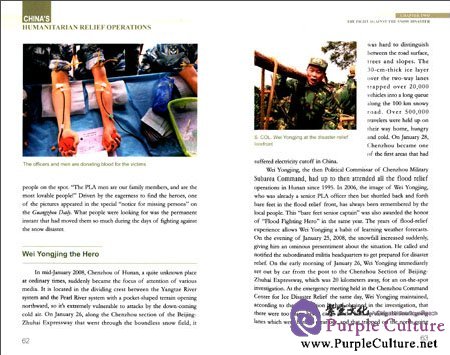Sample Pages Preview

Wei Yongjing the Hero
In mid-January 2008, Chenzhou of Hunan, a quite unknown placeat ordinary times, suddenly became the focus of attention of variousmedia. It is located in the dividing crest between the Yangtze Riversystem and the Pearl River system with a pocket-shaped terrain openingnorthward, so it's extremely vulnerable to attacks by the down-comingcold air. On January 26, along the Chenzhou section of the Beijing-Zhuhai Expressway that went through the boundless snow field, itwas hard to distinguishbetween the road surface,trees and slopes. The30-cm-thick ice layerover the two-way lanestrapped over 20,000vehicles into a long queuealong the 100-km snowyroad. Over 500,000travelers were held up ontheir way home, hungryand cold. On January 28,Chenzhou became oneof the first areas that hadsuffered electricity cutoff in China.
Wei Yongjing, the then Political Commissar of Chenzhou MilitarySubarea Command, had up to then attended all the flood reliefoperations in Hunan since 1995. In 2006, the image of Wei Yongjing,who was already a senior PLA officer then but shuttled back and forthbare feet in the flood relief front, has always been remembered by thelocal people. This bare feet senior captain" was also awarded the honorof "Flood Fighting Hero" in the same year. The years of flood-reliefexperience allows Wei Yongjing a habit of learning weather forecasts.On the evening of January 25, 2008, the snowfall increased suddenly,giving him an ominous presentiment about the situation. He called andnotified the subordinated militia headquarters to get prepared for disasterrelief. On the early morning of January 26, Wei Yongjing immediatelyset out by car from the post to the Chenzhou Section of Beijing-Zhuhai Expressway, which was 20 kilometers away, for an on-the-spotinvestigation
